|
Mercury - Atlas
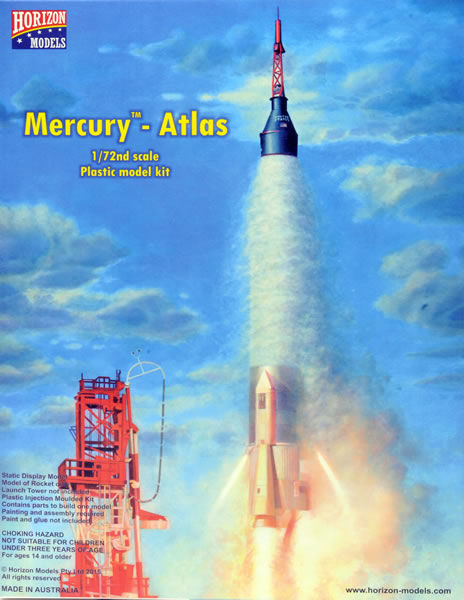
Horizon Models, 1/72 scale
S u m m a r y : |
Catalogue Number: |
Horizon Models Kit No. 2002 – Mercury-Atlas |
Scale: |
1/72 |
Contents & Media: |
63 grey styrene parts, a PE fret of 13 parts and decals for ten missions. |
Price: |
Available online from Horizon Models for US$47.95
Click here for currency conversion |
Review Type: |
First Look |
Advantages: |
Well detailed, crisp moulding, lots of options. |
Disadvantages: |
None noted. |
Conclusion: |
This looks to be an excellent kit, with numerous options enabling the Big Joe, MA-1 to MA-4, and MA-5 to MA-9 missions to be modelled.
Adding strength to the base’s mounting point within the finished model, and improving its stability, is probably worthwhile insurance against your masterpiece falling over.
I highly recommend it. |
Reviewed by
Mark Davies

Kitty Hawk's 1/32 scale OS2U Kingfisher
will be available online from Squadron.com
Project Mercury was the first human spaceflight program of the United States, running from 1958 through 1963. An early highlight of the Space Race, its goal was to put a man into Earth orbit and return him safely, ideally before the Soviet Union. Taken over from the U.S. Air Force by the newly created civilian space agency NASA, it conducted twenty unmanned developmental flights (some using animals), and six successful flights by astronauts. The program, which took its name from the god of travel in Roman mythology, cost $277 million in 1965 US dollars, and involved the work of 2 million people. The astronauts were collectively known as the "Mercury Seven", and each spacecraft was given a name ending with a "7" by its pilot.
Source: Wikipedia
Atlas is a family of American missiles and space launch vehicles. The original Atlas missile was designed in the late 1950s and produced by the Convair Division of General Dynamics, to be used as an intercontinental ballistic missile (ICBM). It was a liquid propellant rocket burning liquid oxygen and RP-1 fuel in three engines configured in an unusual "stage-and-a-half" or "Parallel Staging" design: its two outboard booster engines were jettisoned during ascent, while its centre sustainer engine, propellant tanks and other structural elements were retained through orbital insertion (for orbital flights).
The missiles saw only brief ICBM service, and the last squadron was taken off operational alert in 1965. From 1962 to 1963, Atlas boosters launched the first four American astronauts to orbit the Earth. Various Atlas II models were launched 63 times between 1991 and 2004. There were only six launches of the Atlas III, all between 2000 and 2005. The Atlas V is still in service, with launches planned until 2020.
Source: Wikipedia
Previous 1/72 Scale Mercury Spacecraft & Atlas Launch Vehicle Kits
I am aware of just two previous kits of Project Mercury capsules in 1/72 scale, these being by Real Space Models and Dragon:
- The Real Space Models kits are resin, and come in four boxings; three are the capsule with one of the three launch vehicles used in the program, Little Joe, Redstone and Atlas; and one is boxed with Gemini and Apollo capsules.
- The Dragon kit is injected styrene and comes with the Redstone launch vehicle.
I am also only aware of two previous Atlas launch vehicle/ICBM kits in 1/72 scale, these are both resin by Real Space Models and Anigrand:
- The Real Space Models kit includes their Mercury capsule kit mentioned above to complete a model of Friendship 7.
- The Anigrand kit does not include any Mercury options; instead it covers options doe the Convair X-11, X-12, XB-65, SM-65, CGM-16 and Atlas ICBM.
There may well be others in ‘The One True Scale’, Revell comes to mind here, but space models are not my forte. For this reason, I also cannot comment on the accuracy of the kits discussed here.
The Contents
The kit comes packed in an end-opening box with art-work on the front and coloured illustrations of three configuration options covered on its rear. The instructions are a multi-folded sheet forming eight pages of clearly drawn assembly drawings.
The kit consists of a four main sprues, each in its own cellophane bag, with a PE fret and decals further enclosed in their own bags. One sprue provides the capsule and adapter section for it to fit the launch vehicle; this being the same sprue supplied as a pair in Horizon Models’ Mercury Spacecraft twin-pack kit (boxing #2003). The other three sprues cover the Atlas launch vehicles, and are shared in common with Horizon Models’ Convair SM-65D Atlas ICBM kit (boxing #2001).
The kit is designed in Australia, which is also where the PE parts and box are made, whilst the plastic parts are moulded in China and the decals printed in the USA by Microscale.
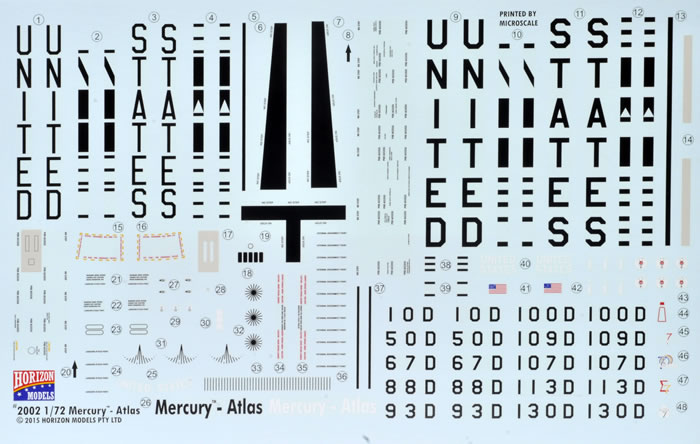
The kit provides parts and markings for the Big Joe (boiler Plate), MA-1 to MA-4 (Porthole), and MA-5 to MA-9 (window) mission configurations, along with markings for each. The manned capsule can be completed in launch configuration with retro-pack, nose fairing and escape tower; orbital configuration with retro pack; or re-entry mode with just the capsule.
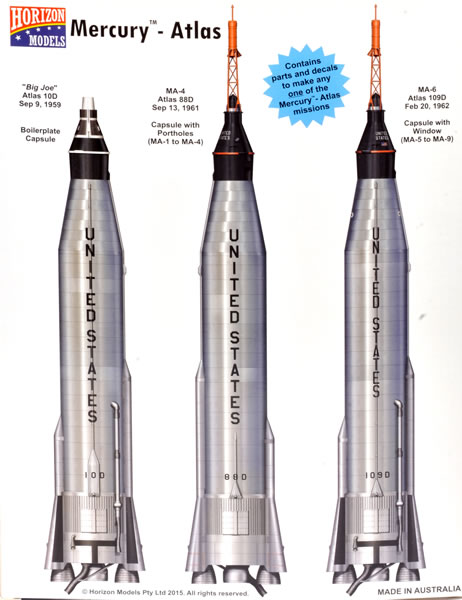
The Kit
The instructions are downloadable from Horizon Models’ website as well as being supplied in the box. It is soon apparent that one needs to decide which mission is to be modelled before starting assembly, as quite few detail differences apply to each, along with individual markings. I recommend the instructions be read several times to be fully conversant with the mission differences to be modelled, particularly in respect of the capsule.
Colour call outs are generic, and keyed throughout the instructions. A small point, but I liked the fact that the parts map gives the functional names of the items illustrated; this adds interest, and reminds me of how as a young boy I learned the names of airframe parts from the old 1960’s style Airfix instructions.
The parts are crisply moulded and delicate where necessary. Sprue gates are quite fine, but care separating parts will be needed, with perhaps PE razor saws being the best option in some cases. The quality of the PE is very good, and the decals appear excellent in all respects.
The Capsule
Some points to note about the capsule include:
- The louvered external finish of the functional capsule is nicely done, and is captured using three sections for tooling reasons. These are assembled around a central tubular core;
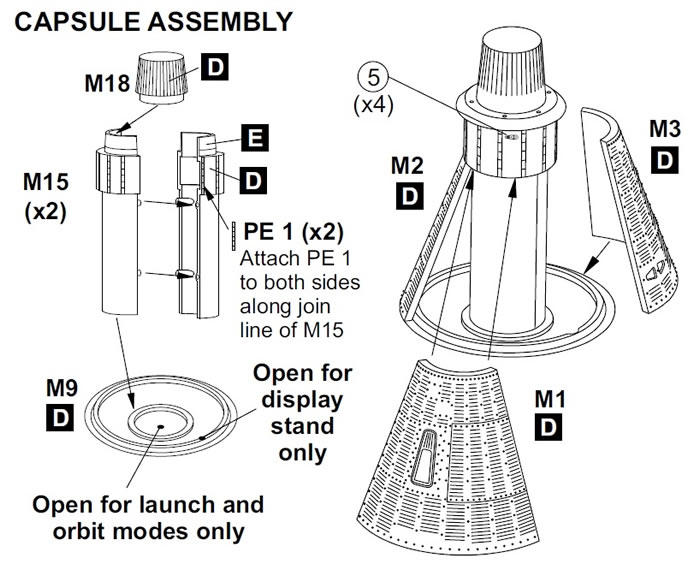
- The simpler boiler plate mass-simulator ‘capsule’ is moulded as a single piece, to which the same heat-shield as used for the functional capsule is added.
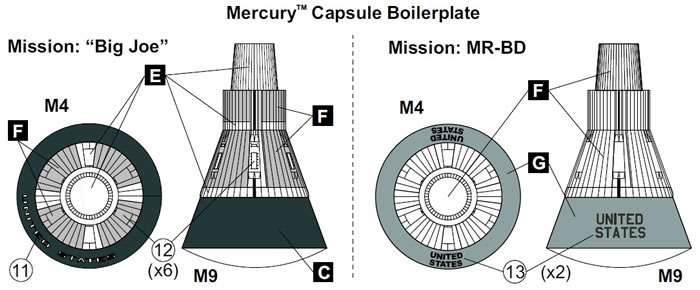
- The escape tower includes some finely moulded parts, and looks to be the most challenging aspect of assembly involving the plastic components.
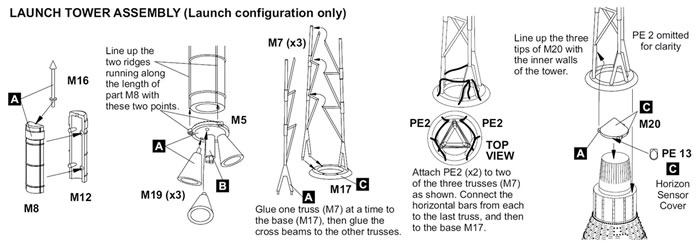
- Differences between the various functional capsules are catered for by PE details like portholes, alternate hatch, and rows of bolts, all of which must be glued to the craft’s louvered skin.

- Obviously the PE parts will need to be annealed and curved to match the capsule’s conical form. I confess to wondering how convincing and fully integrated these appliqué parts will look under close scrutiny at least; although I must admit that fret is made of very thin PE, so it will probably be fine.
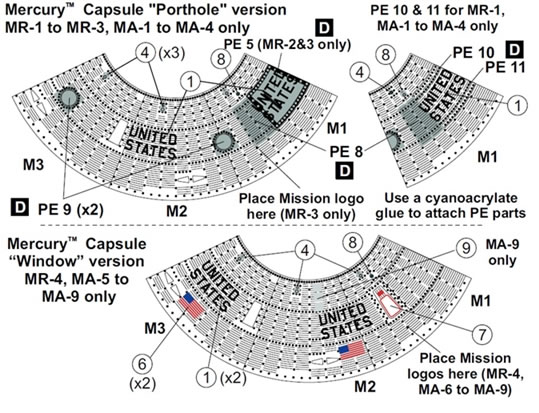
- PE also provides the retro-pack restraining cord, the escape tower straps, sensors, LOX-vent and its cover.
The Atlas Launch Vehicle
Two of the three sprues are identical and the unused parts on all seem to include re-entry vehicles associated with the ICBM versions. Points to note include:
- Quite a number of blind holes must be opened in the body of the launcher.
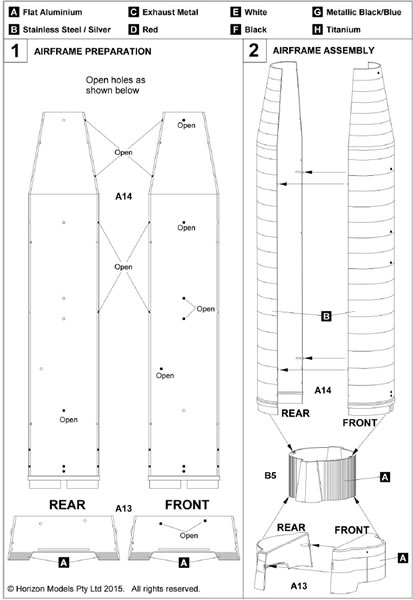
- Cable way fairings, LOX pressure lines, and equipment fairings locate in the various holes previously opened up.
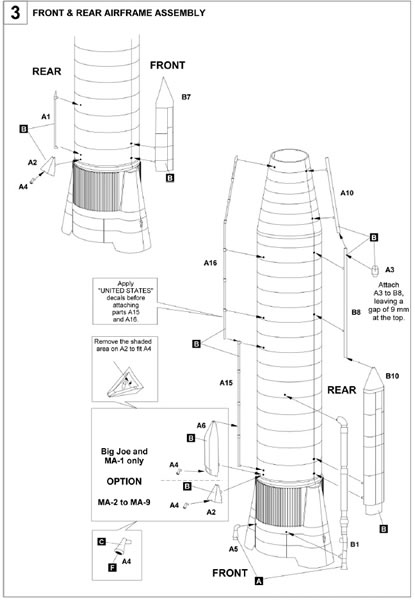
-
There is one choice that needs to be made between large or small vernier fairings, the larger of the two applying to just the Big Joe and MA-1 missions.
-
The three rocket engines and booster engine turbine exhaust duct all mount on the fire-shield nacelle (the plate that inserts inside the bottom of the launcher).
-
Comprehensive stencilling is provided and the instructions clearly show where various high quality decals go.
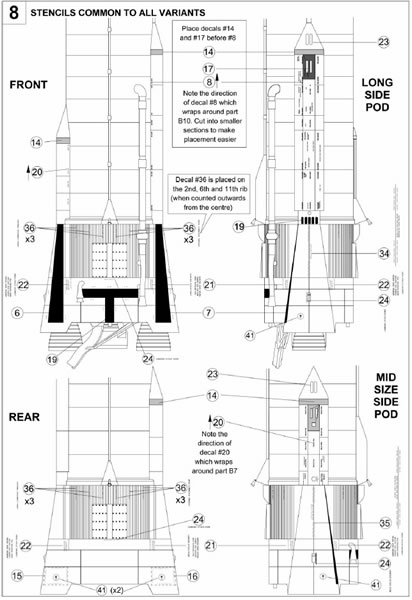
- The display base inserts into the centre sustainer engine (parts B2 & B3 – see below), which means the entire model is supported by a 12mm (0.5”) diameter peg inserted just 8mm (0.3mm) into the engine. The engine in turn is attached to the rest of the model by just a small tab measuring around 2x2x1mm (0.08x0.08x0.04”). Added to this seemingly precarious hold on the 412mm (16.2”) high model is the fact that base is feather-light and has a small footprint only 76mm (3”) in diameter.

- I would seriously consider using epoxy around the outside of the sustainer engine deep inside its surrounding well within the fire-shield. This 7mm (0.3”) deep well could be half-filled with epoxy to give a much stronger join between the engine and remainder of the model, yet will remain unseen. It should also be possible to fill the shallow base with lead shot or other ballast, either glued in place or retained by a suitable scratch-built plastic disc, to reduce the risk of the model toppling over; or the base could be fixed to a larger area base (probably the best option).
I think this looks to be great kit, and a worthy tribute to NASA’s first manned space missions, made all the more poignant by the death just on a month ago of a true American hero, John Glenn.
Horizon Model’s website also advises that a Mercury-Redstone kit is to be released shortly, which will cover the sub-orbital missions.
Award Winner
Horizon’s website also mentions that the kit was winner of the 2016 ModellFan "Modell des Jahres" (Model of the Year) in the category of Science Fiction/Fantasy. It seems ironic that a true-life subject gets classified with fictional ones, but it says a lot for the kit if it beat the various movie-derived competitors I assume it was judged against.
This looks to be an excellent kit, with numerous options enabling the Big Joe, MA-1 to MA-4, and MA-5 to MA-9 missions to be modelled.
Adding strength to the base’s mounting point within the finished model, and improving its stability, is probably worthwhile insurance against your masterpiece falling over.
I highly recommend it.
Thanks to Horizon Models for the review sample.
Review Text Copyright © 2017 by Mark Davies
Page Created 9 January, 2017
Last updated
9 January, 2017
Back to HyperScale Main Page
Back to Reviews Page

|
